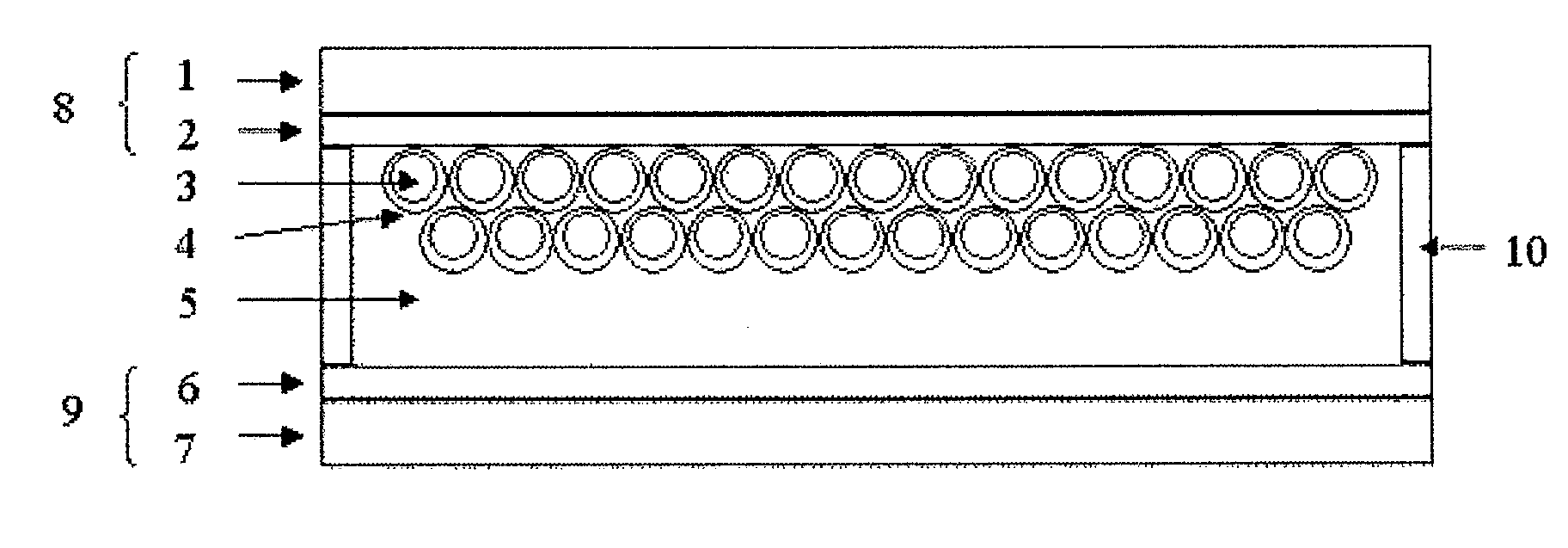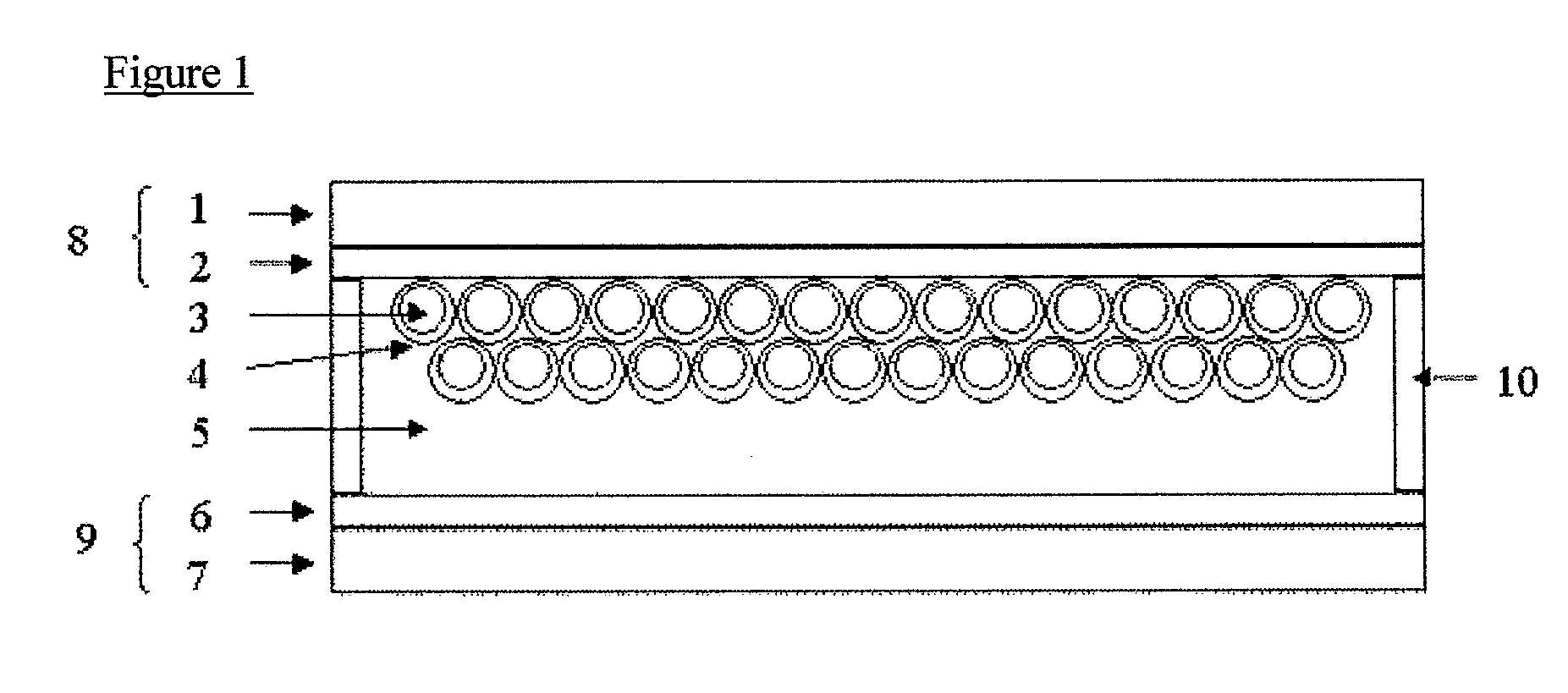Compound, photoelectric conversion device and photoelectrochemical battery
- Summary
- Abstract
- Description
- Claims
- Application Information
AI Technical Summary
Problems solved by technology
Method used
Image
Examples
production example 1
Production Example of Compound (I-47)
[0128]A reaction vessel was purged with nitrogen, and 29 mg (0.05 mmol, purchased from Kanto Chemical Co., Inc.) of [RuCl2(p-cymene)]2 and 50 ml of N,N-dimethylformamide were charged, they were stirred at room temperature, and dissolution thereof was confirmed. Thereafter, 24 mg (0.10 mmol, purchased from AVOCADO) of compound III-1 was charged and the mixture was stirred at 70° C. for 4 hours, and disappearance of the raw materials was confirmed by HPLC. Then, 46 mg (0.10 mmol) of compound II-4 (prepared according to description of Monatshefte fuer Chemie (1988), 119(1), 1 to 15) was charged, and the temperature was raised up to 130° C. and the mixture was stirred for 6 hours. Thereafter, a solution prepared by dissolving 146 mg (1.50 mmol) of potassium thiocyanate in 3 ml of water was charged, and the mixture was stirred at 120° C. for 5 hours.
[0129]After the reaction, the reaction solution was concentrated by an evaporator, a highly-purified pu...
example 1
[0131]A titanium oxide dispersion Ti-Nanoxide T / SP (trade name, manufactured by Solaronix) was applied using a screen printer on the electroconductive surface of electroconductive glass having a tin oxide film doped with fluorine (manufactured by Nippon Sheet Glass Co., Ltd., 10 Ω / □) as an electroconductive substrate, then, the coated glass was calcined at 500° C., and cooled, to laminate a semiconductor fine particle layer on the electroconductive substrate. Subsequently, it was immersed for 16 hours in a solution of the compound (I-47) (concentration is 0.0003 mol / liter, solvent is ethanol, and chenodeoxycholic acid is added at 0.01 mol / liter) and taken out from the solution, then, washed with acetonitrile, then, dried naturally to obtain a laminate (area of titanium oxide electrode is 24 mm2) composed of the electroconductive substrate and the semiconductor fine particle layer having the photosensitizing coloring matter adsorbed thereon. Then, around the layer, a polyethylene ter...
production example 2
Production Example of Compound (I-83)
[0133]A reaction vessel was purged with nitrogen, and 27 mg (0.04 mmol, purchased from Kanto Chemical Co., Inc.) of [RuCl2(p-cymene)]2 and 8 ml of N,N-dimethylformamide were charged, they were stirred at room temperature, and dissolution thereof was confirmed. Thereafter, 40 mg (0.09 mmol) of compound (IV-9) was charged and the mixture was stirred at 60° C. for 30 minutes, and disappearance of the raw materials was confirmed by HPLC. Then, 41 mg (0.09 mmol) of compound II-4 (prepared according to description of Monatshefte fuer Chemie (1988), 119(1), 1 to 15) was charged, and the temperature was raised up to 100° C. and one hour later, the mixture was heated up to 140° C. and stirred for 2 hours. Thereafter, a solution prepared by dissolving 129 mg (1.33 mmol) of potassium thiocyanate in 1.2 ml of water was charged, and the mixture was stirred at 60° C. for 1 hour, then, heated up to 105° C. and stirred with heating for 1 hour.
[0134]After the rea...
PUM
 Login to View More
Login to View More Abstract
Description
Claims
Application Information
 Login to View More
Login to View More - R&D
- Intellectual Property
- Life Sciences
- Materials
- Tech Scout
- Unparalleled Data Quality
- Higher Quality Content
- 60% Fewer Hallucinations
Browse by: Latest US Patents, China's latest patents, Technical Efficacy Thesaurus, Application Domain, Technology Topic, Popular Technical Reports.
© 2025 PatSnap. All rights reserved.Legal|Privacy policy|Modern Slavery Act Transparency Statement|Sitemap|About US| Contact US: help@patsnap.com



